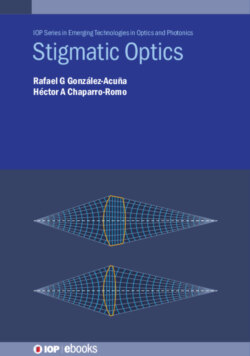Читать книгу Stigmatic Optics - Rafael G González-Acuña - Страница 8
На сайте Литреса книга снята с продажи.
Series Editor’s foreword
ОглавлениеFor over a millennium, scientists have attempted to create mirrors and lenses free of spherical aberration that is the only monochromatic axial aberration. Geometrical imaging of an axial point object to form a perfect axial point image is known as axial stigmatic imaging. When an optical system produces a perfect image over the entire field-of-view, it known as a stigmatic optical system. Over time, it was learned that spherical aberration is a constant aberration over the entirety of the image surface. For a long time, it has been known that certain forms of lenses provided axial stigmatic imaging. For example, when the object is at infinity, a geometrically-perfect point image can be formed by a lens having (i) an ellipsoidal front surface and a plane rear surface or (ii) a plane front surface and hyperbolic rear surface. A stigmatic image for finite conjugates (magnification < 0) can be formed by using a pair of plano-hyperbolic lenses (having focal length of f1 and f2) with the plane surface facing one another. The magnification is simply −f2/f1. An example of a mirror forming a stigmatic image is a parabola with the object at infinity. Although such lenses and mirrors suffer no spherical aberration, other aberrations such as coma and astigmatism can be bothersome. Indeed, a fast parabola can become useless for imaging due to coma.
It is generally understood that there is not a generalized closed-form solution to the design of a singlet lens that is axially stigmatic, i.e., one that is free of spherical aberration. The authors of this treatise, Stigmatic Optics, elegantly attack this challenge to develop such a generalized closed-form solution. They begin the book by presenting Maxwell’s equations describing the behavior of electromagnetic fields and develop the eikonal equation that provides the basis for geometric ray propagation equation and Snell’s Law. Next is provided the necessary mathematics needed to understand their development of the equations describing the surfaces of lenses having the property of axial stigmatic imaging. Optical systems utilizing Cartesian ovals are comprehensively discussed and numerous examples are provided. Subsequently, they meticulously develop the general equations for designing axial stigmatic lenes. The resultant surface shapes can be described by a combination of a conventional shape and an aspheric shape, or both surfaces being aspheric. These surfaces, in general, cannot be described by the well-known polynomial aspheric equation commonly used in lens design computer programs. The authors skillfully explain the development of their new aspheric equations and provide numerous examples. Throughout the book, the authors have richly included graphics that aid in clarification of their discussions. Readers will likely appreciate that the authors included computer code for algorithms useful in computing axial stigmatic designs.
Stigmatic Optics is an excellent book to gain an understanding of the basics of optical imaging and the formulation of the new aspheric shapes for achieving axial stigmatic imaging. To continue learning about this topic, readers are encouraged to read Analytical Lens Design by these authors, along with Julio C Gutiérrez-Vega, which also explores the development of aspherical-shaped surface(s) that create lenses which are aplanatic, i.e., free of both spherical aberration and linear coma. One might ask the question: ‘what is the value of this rather esoteric approach to lens design using closed-form solutions?’. My answer is that exploring closed-form solutions can provide further insight into creating better optical systems, although closed-form solutions of complex optical systems seems improbable. Also, recent advances in manufacturing free-form surfaces makes possible the creation of lenses incorporating the authors’ new aspheric shapes.
R Barry Johnson, FInstP, FOSA, FSPIE, HonSPIE
Series Editor, Emerging Technologies in Optics and Photonics
Huntsville, Alabama
